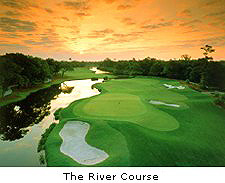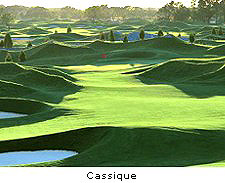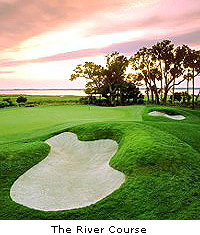- Alabama
- Arkansas
- Arizona
- California
- Colorado
- Connecticut
- Florida
- Georgia
- Illinois
- Indiana
- Michigan
- Missouri
- Montana
- Nevada
- New Mexico
- North Carolina
- Pennsylvania
- South Carolina
- Tennessee
- Texas
- Virginia
- Washington
- Wyoming
 FEATURE STORY
FEATURE STORY
Private side of Kiawah remains a secret to many
By Shane Sharp,
Contributing Writer
KIAWAH ISLAND, S.C. - The sumptuous men's locker room at Cassique runneth over with tales of sand saves from shoulder-deep pot bunkers, smartly played bump-and-run shots, and five-foot birdie putts gone bad. From the heroic yarns to the tragic anecdotes, it is obvious this fortunate crop of members is not just intimately familiar with this visually stunning, extremely private, Tom Watson designed links course.
They adore it.
To the members, go the spoils.
Most have-clubs-will-travel duffers have either played or dreamed of playing The Ocean Course at Kiawah Island Golf Resort. Since opening and hosting the Ryder Cup in 1991, the Pete Dye design has evolved into one of the preeminent seaside links layouts in the U.S.
Yet the private golf component of the island -- the Kiawah Island Club -- is a relative unknown to most traveling golfers. This bastion of Lowcountry living is home to two world beater, 18-hole layouts, a breezy 10,000-square-foot Beach Club, a new state-of-the-art spa and enough Southern hospitality to last a lifetime.
The Kiawah Island Club's inaugural course, The River Course, is a haunting, Tom Fazio designed brute that snakes along the reed-choked banks of Kiawah River and the shimmering shores of "Bass Pond." Linksy Cassique -- Watson's only North American design credit and the more critically acclaimed of the two layouts -- followed in 2001.
The entire package is the brainchild of Kiawah Development Partners, a visionary group of investors with an unwavering passion for the game and an insatiable desire to place Kiawah Island among the top golf spots in the world.
"We had been in existence for some time without a private club," says Buddy Darby, chairman and chief executive officer of Kiawah Development Partners. "Residents of the island were tired of competing for tee times with resort guests."
 Nowadays, the only thing the members grow tired of is trying to choose between The River Course and Cassique. Even that decision is manageable, because a membership at the Kiawah Island Club covers both courses. According to Darby, Cassique was the leader in the clubhouse shortly after it opened in terms of popularity. But now play is spread fairly evenly between the two.
Nowadays, the only thing the members grow tired of is trying to choose between The River Course and Cassique. Even that decision is manageable, because a membership at the Kiawah Island Club covers both courses. According to Darby, Cassique was the leader in the clubhouse shortly after it opened in terms of popularity. But now play is spread fairly evenly between the two.
"They are so different, you either wake up wanting to play one or the other," Darby says.
The River Course -- located on the site of the island's first English settlement -- is as Lowcountry as She Crab Soup. The 7,039-yard track is situated on a 300-acre swath of land that contains more protected wetlands than it does golf course. Fazio's routing takes golfers a mile and a half along the Kiawah River and through "clusters" of holes separated by large expanses of green space.
"At the time, Fazio had just done Shadow Creek, Wade Hampton and the Wild Dunes links course," Darby says. "He had done some amazing work. I wanted three things on that course and I knew he was the guy to do it."
A fan of A.E. Tillinghast, Seth Raynor, and other classic designers, Darby had a hankering for majestic, raised green complexes. He was also adamant about having plenty of undulation in the fairways and greens. Lowcountry, Darby reasoned, was no excuse to be low profile.
 "We moved 500,000 yards of dirt to build The River Course and I thought that was a lot until we moved a million to do Cassique," Darby says laughing.
"We moved 500,000 yards of dirt to build The River Course and I thought that was a lot until we moved a million to do Cassique," Darby says laughing.
In contrast to The River Course, a good portion of Cassique turns the Lowcountry on its head. Namely, the front nine, with its dramatic mounding, stacked sod pot bunkers and large, rolling greens. The back nine is more in keeping with the Lowcountry standards of thick patches of Live Oaks and expansive coastal marshes.
Every hole at Cassique, links or Lowcountry, was crafted with the assistance of the Kiawah Development Partner's in-house design guru, Charlie Arrington. While Watson was borderline hyperactive with the design of Cassique, making nearly a dozen site visits and testing almost every shot value, Arrington was the driving force behind the day-to-day work.
"I have to give Charlie a lot of credit for coming up with some of the landform ideas," Watson said during a recent interview prior to the course hosting the Palmer Cup. "I give him almost all of the credit for that. The design and strategy, I added quite a bit to that."
Given their differences, it is only appropriate that Cassique and The River Course occupy their own unique space on the island. In fact, Cassique is located off island, near the entrance to the resort, while the River Course sits about halfway down the main island thoroughfare. (Both courses, however, are home to one of the few caddy programs in the Southeastern U.S.)
Both courses sport clubhouses worthy of architectural asides. The 42,000-square-foot River Course clubhouse was modeled after a 19th century Lowcountry estate. The slightly smaller, English country style clubhouse at Cassique was inspired by the work of prominent British architect C.F.A. Voysey.
Either can be your home away from home, if the price is right. The Kiawah Island Club is a non-equity private club (members do not take partial ownership of the course) with a $135,000 initiation fee that is 100 percent refundable upon leaving the club. Property ownership is required, and the pickings are prodigious.
Kiawah Island Real Estate currently has available homes and lots available in three neighborhoods: The Settlement, Cassique, and The Preserve. Should you take a liking to the River Course, The Settlement is located just beyond the course's front gate within walking distance to the club. If Cassique is more your bag, the Cassique community provides full separation from resort guests and easy access to the course and club. The Preserve is situated on the island's northeast tip and is surrounded by salt marshes, tidal creeks and the Kiawah River. Prices in all three communities, for home and lot, range from $450,000 to over $1.4 million
Every inch of development on the island is environmentally sensitive to the point of being a prototype; The Preserve being a case in point. The entire site was first studied by an environmental resource firm, and two thirds of the area is set aside for conservation and preservation. All development on the Island is carefully buffered and ribbons of nature trails crossing between neighborhoods.
"We come at everything we do from a very environmentally sensitive standpoint," Darby says. "We take it slow out here and make sure we do it right. We still have about 10 years to go on this thing.".
Essentials
Kiawah Island Club
800-277-7008
P.O. Box 12001 Charleston, S.C. 29422
Orientation
Kiawah Island is located approximately 21 miles south of Charleston. From the north, take I-95 south to I-26. Take I-26 east to I-526 east toward Savannah. Interstate 526 ends at U.S. 17. Take U.S. 17 south and follow the signs to Kiawah Island.
Stay, play, and eat
Prospective members can stay in one of the Kiawah Island Clubs spacious, two- and three-bedroom Club Cottages. Cottages are equipped with full kitchen, separate bathrooms, living room with vaulted ceiling, fireplace and outdoor patios. Dining options range from upscale casual at the Beach Club, to fine dining at Cassique and The River Course. Just off the Island and on the way to Seabrook Island, the Privateer is the place to catch some nightlife, a plate of seafood, and a cold beverage.
August 4, 2003
Any opinions expressed above are those of the writer and do not necessarily represent the views of the management. The information in this story was accurate at the time of publication. All contact information, directions and prices should be confirmed directly with the golf course or resort before making reservations and/or travel plans.

